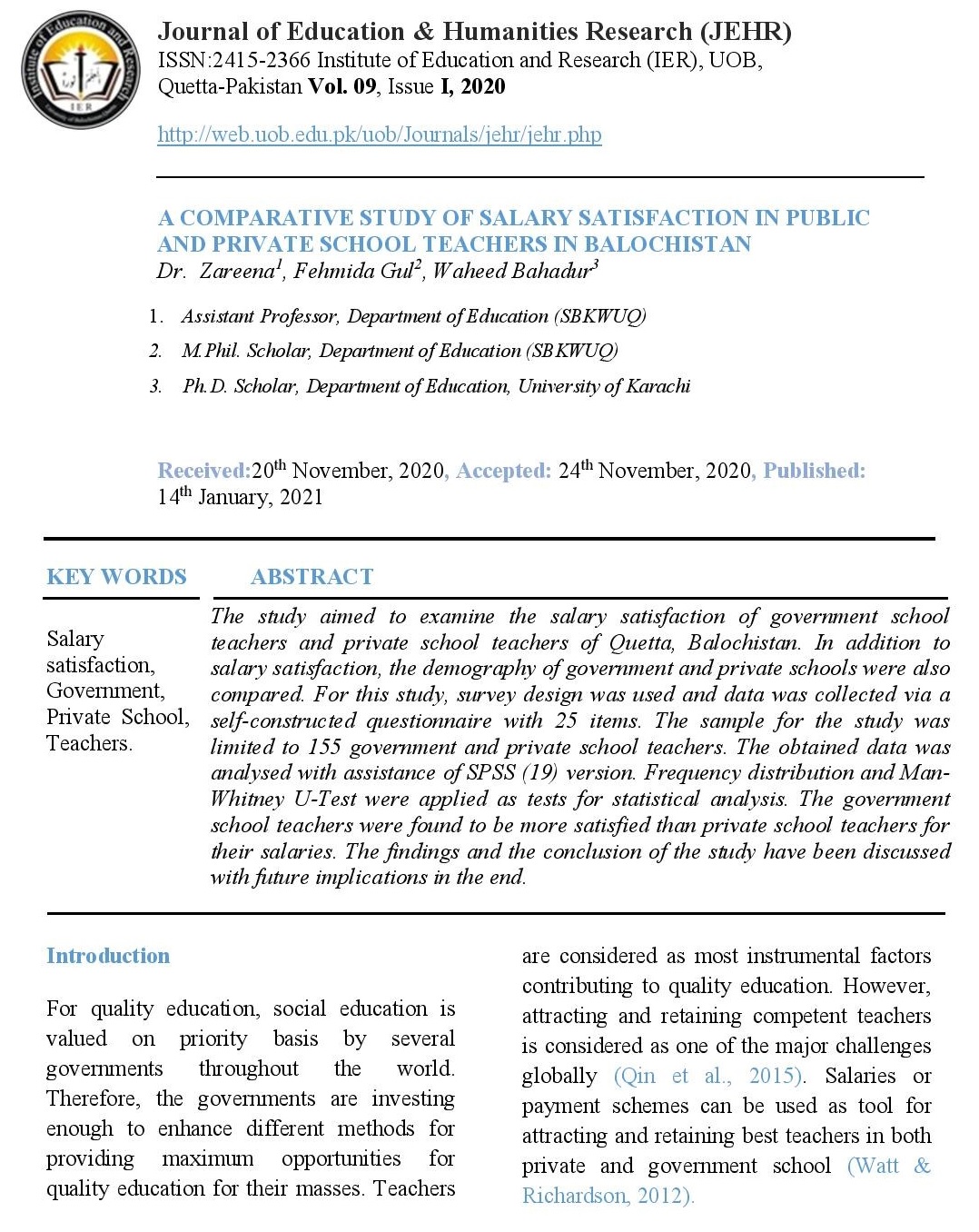SALARY SATISFACTION OF GOVERNMENT AND PRIVATE SCHOOL TEACHERS OF BALOCHISTAN
Keywords:
Salary satisfaction, Government, Private School, TeachersAbstract
The study aimed to examine the salary satisfaction of government school teachers and private school teachers of Quetta, Balochistan. The study was conducted with demography of the participants. The survey study was quantitative in nature and comprised of a self-constructed questionnaire with 25 items. The sample for the study was limited to 108 government and private school teachers. The obtained data was analysed with assistance of SPSS (19) version. Frequency distribution and Man-Whitney U-Test was applied as tests for statistical analysis. The government school teachers were found with significant satisfaction rather than private school teachers. The findings and the conclusion of the study has been discussed with future implications in the end.
References
Aydin, (2009), The employee satisfaction in metalworking manufacturing: How do organizational culture and organizational learning capacity jointly affect it? Journal of industrial Engineering and Management, 01(02), 143-168.
Chase, C. I. (1985). Two thousand teachers view their profession. The Journal of Educational Research, 79(1), 12-18.
Chiu, R. (2000). Does perception of pay equity, pay satisfaction, and job satisfaction mediate the effect of positive affectivity on work motivation?. Social Behavior & Personality: an international journal, 28(2).
Creswell, J. W. (2012). Educational research:Planning, conducting and evaluating quantitative and qualitative research (4th ed.). Pearson Education Inc.
Davis, J., & Wilson, S. M. (2000). Principals' efforts to empower teachers: Effects on teacher motivation and job satisfaction and stress. The clearing house, 73(6), 349-353.
Escribà-Agüir, V., Artazcoz, L., & Perez-Hoyos, S. (2008). Effect of psychosocial work environment and job satisfaction on burnout syndrome among specialist physicians. Gaceta Sanitaria, 22(4), 300-308.
Farber, B. A. (1991). Crisis in education: Stress and burnout in the American teacher. Jossey-Bass.
Griffin, M. A., & Neal, A. (2000). Perceptions of safety at work: a framework for linking safety climate to safety performance, knowledge, and motivation. Journal of occupational health psychology, 5(3), 347.
Hannum, E. (2003). Poverty and basic education in rural China: Villages, households, and girls’ and boys’ Enrolment. Comparative Education Review, 47(2), 141-159.
Heinemann, F. (2000). Unique equilibrium in a model of self-fulfilling currency attacks: Comment. American Economic Review, 90(1), 316-318.
Herzberg (1996). Herzberg's theory of motivation and Maslow's hierarchy of needs. Practical Assessment, Research, and Evaluation, 5(1), 11.
Herzberg, F., 1959. The Motivation To Work. New York: Wiley.
Hoy, W. K., & Miskel, C. G. (2008). Theory, research and practice in educational administration. Translated to Persian by: Abaszadeh S. Urmia: Urmia University pub, 2008, 88-46.
Kingdon, G. G. (2006). Teacher Pay and Student Performance: A Pupil Fixed-Effects Approach. Manuscript. Oxford University.
Lee, H. W., & Lin, M. C. (2014). A study of salary satisfaction and job enthusiasm – mediating effects of psychological contract. Applied Financial Economics, 24(24), 1577–1583. https://doi.org/10.1080/09603107.2013.829197
Malveaux, S. M. (2010). Front Loading and Heavy Lifting: How Pre-Dismissal Discovery Can Address the Detrimental Effect of Iqbal on Civil Rights Cases. Lewis & Clark L. Rev., 14, 65.
Manan, S. A. (2019). Myth of English teaching and learning: a study of practices in the low-cost schools in Pakistan. Asian Englishes, 21(2), 172–189. https://doi.org/10.1080/13488678.2018.1503041
Memon, M. A., Salleh, R., & Baharom, M. N. R. (2015). Linking Person-Job Fit, Person-organization fit, employee engagement and turnover intention: A three-step conceptual model. Asian Social Science, 11(2), 313.
Mhozya, C. M. (2007). The extent to which incentives influence primary school teachers’ job satisfaction in Botswana. The Social Sciences journal.
Nadim, M., Chaudhry, M. S., Kalyar, M. N., & Riaz, T. (2012). Effects of Motivational Factors on Teachers ’ Job Satisfaction : a Study on Public Sector Degree Colleges of Punjab , Pakistan. The Journal of Commerce, 4(4), 25–32.
Osibanjo, A. O., Adeniji, A. A., Falola, H. O., & Heirsmac, P. T. (2014). Compensation packages: a strategic tool for employees' performance and retention. Leonardo Journal of Sciences, (25), 65-84.
Price HE (2012) Principal–teacher interactions: How affective relationships shape principal and teacher attitudes. Educational Administration Quarterly 48(1): 39–85.
Qin, T. ., Zarina, R., Zainuddin, I., Jasmine, S., Shing, N. ., Sunitha, M., & Abdelaziz, N. (2015). TEACHERS’ BACKGROUND FACTORS AND ITS RELATION TO MOTIVATION. Malaysian Online Journal of Educational Management, 3(2), 1–17. http://mojem.um.edu.my/filebank/published_article/7371/Latest_Volume 3(2)-1.pdf
Rosner, B., & Grove, D. (1999). Use of the Mann-Whitney U-test for clustered data. Statistics in Medicine, 18(11), 1387–1400. https://doi.org/10.1002/(SICI)1097-0258(19990615)18:11<1387::AID-SIM126>3.0.CO;2-V
Smithers, G. L., & Walker, D. H. (2000). The effect of the workplace on motivation and demotivation of construction professionals. Construction management and economics, 18(7), 833-841.
Somech A and Bogler R (2002) Antecedents and consequences of teacher organizational and professional commitment. Educational Administration Quarterly 38: 555–577.
Watt, H. M. G., & Richardson, P. W. (2012). An introduction to teaching motivations in different countries : comparisons using the FIT-Choice scale. Asia-Pacific Journal of Teacher Education, 40(3), 185–197.
Zembylas, M., & Barker, H. B. (2002). Preservice teacher attitudes and emotions: Individual spaces, community conversations and transformations. Research in science education, 32(3), 329-351.




